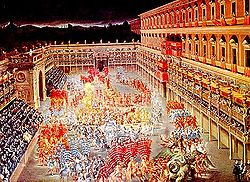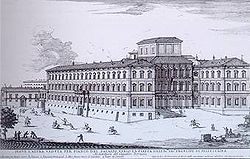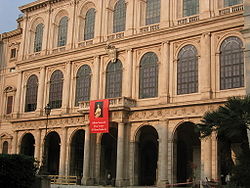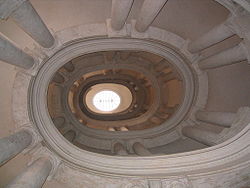- Palazzo Barberini
-
Palais Barberini
Escalier hélicoïdal de Francesco Borromini.
 Les festivités en l'honneur de la reine Christine de Suède.
Les festivités en l'honneur de la reine Christine de Suède.
Le palais Barberini est un palais de Rome, œuvre de Carlo Maderno qui en commence la construction en 1627, assisté de son neveu Francesco Borromini qui reprend le chantier à la mort de son oncle en 1629 et qui collabore tout d'abord avec Le Bernin lequel en termine la construction, seul, en 1633.
Il est dû à la commande du pape Urbain VIII qui avait acheté le terrain aux Sforza en 1625. Entre 1633 et 1639, Pierre de Cortone exécute pour le pape Urbain VIII sa fresque la plus célèbre, la Gloire des Barberini qui orne le plafond du grand salon du palais. Ce décor peint est aussi appelé le Triomphe de la Divine Providence. Il s’agit d’une allégorie de la Providence et du pouvoir divin des Barberini. Cette grande fresque est mouvementée, abonde de personnages vus dans une contre-plongée extrême (sotto in su), qui caractérise ses effets illusionnistes.
Carlo Maderno, Gian Lorenzo Bernini, et Francesco Borromini ont également participé à la décoration intérieure.
Le palais est confisqué par le pape Innocent X à la mort d'Urbain VIII mais rendu aux Barberini en 1653.
En 1656, des fêtes y sont organisées en l'honneur de la visite de la reine Christine de Suède.
La Convention européenne des droits de l'homme y est signée le 4 novembre 1950.
Le palais abrite la Galerie nationale d'art ancien (Galleria nazionale d'arte antica) et un mithraeum, découvert en 1936 et qui compte parmi les mieux conservés.
Annexes
Catégories : Architecture baroque italienne | Palais romain | Musée de Rome | Francesco Borromini
Wikimedia Foundation. 2010.




